Light: Reflection & Refraction - Class 10th Science
NCERT Exercise Solution: Q:9-16
Question: 9. One half of a convex lens is covered with a black paper. Will this lens produce a complete image of the object? Verify your answer experimentally. Explain your observations.
Answer: Yes, if one half of a convex lens is covered with a black paper, it produces a complete image of the object.
Experiment:
One half of a convex lens covered with black paper is taken.
An object is placed infront of it, say beyond 2F1
It produces a diminished, real and inverted image between F2 and 2F2
Experiment is repeated by placing object at different positions.
In all cases image is formed.
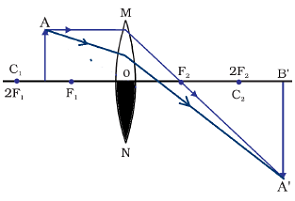
Since, rays coming from object passes through the upper part and optical centre of the lens, so a half portion covered convex lens with black paper produces image easily.
Question: 10. An object 5cm in length is held 25cm away from a converging lens of focal length 10cm. Draw the ray diagram and find the position, size and the nature of the image formed.
Answer: Here given,
Size of object: 5cm
Distance of object (u): –25cm
Focal length (f) = 10cm
Distance of image (v) =?
We know that in the case of a converging lens 
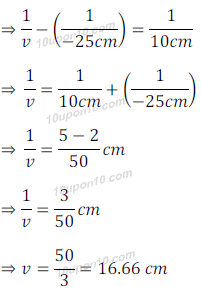
We know that, magnification
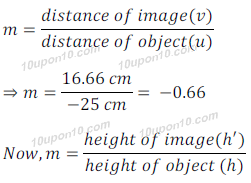
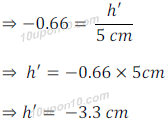
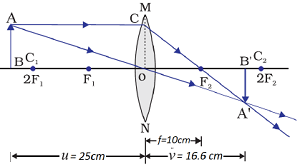
Position of image: Between F2 and 2F2, i.e. at the other side of lens.
Size of image: – 3.3 cm, i.e. smaller than object.
Nature of image: Inverted and real
Question: 11. A concave lens of focal length 15cm forms an image 10cm from the lens. How far is the object placed from lens? Draw a ray diagram.
Answer: Given,
Focal length of concave lens (f) = – 15cm
Distance of image (v) = – 10cm
Distance of object (u) = ?
We know that in the case of a converging lens
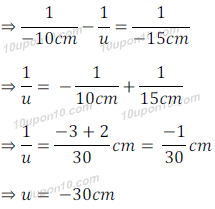
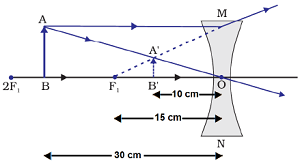
Thus, object is place at distance of 30cm from the lens i.e. at 2F1 of the concave lens.
Question: 12. An object is placed at a distance of 10cm from a convex mirror of focal length 15cm. Find the position and nature of the image.
Answer: Given,
Distance of object (u) = – 10cm
Focal length = 15cm
Therefore, Distance of image (v) =?
We know that for a spherical mirror 
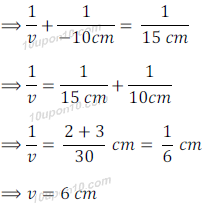
Now, magnification
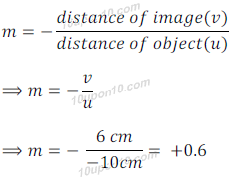
Since distance of image is positive, this shows that image is formed at the other side of the mirror. And magnification is also positive this shows that image is erect.
Thus, Position of image = 6cm (behind the mirror, because distance of image is positive)
Nature of image = Virtual and erect (Because magnification is positive and image is formed behind the mirror)
Question: 13. The magnification produced by a plane mirror is +1. What does it mean?
Answer: Magnification produced by a plane mirror is +1 means,
(a) Size of image is equal to the size of object
(b) Positive sign in the magnification shows that image is erect.
Explanation: A plane mirror always form image of same size as of the size of object. And a plane mirror always forms a virtual and erected image.
Question: 14. An object 5.0 cm in length is placed at a distance of 20cm in front of a convex mirror of radius of curvature 30cm. Find the position of the image, its nature and size.
Answer: Given
Size of objet = 5.0 cm
Distance of object = – 20cm
Radius of curvature (R) = 30cm
Thus, focal length = R/2 = 30cm/2 = 15cm
Distance of image (v) = ?
And magnification (m) = ?
We know that, 
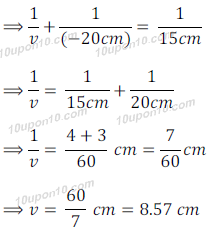
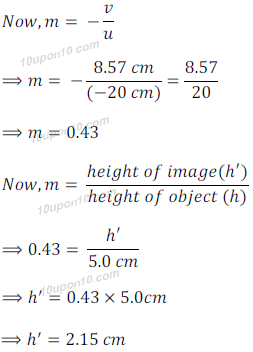
Thus,
Position of image = 8.57 cm behind the mirror
Size of image = 2.15 cm which is smaller than the object
Nature of image = virtual and erect (Because distance of image and magnification both are positive)
Question: 15. An object of size 7.0 cm is placed at 27cm in front of a concave mirror of focal length 18cm. At what distance from the mirror should a screen be placed, so that a sharp focused image can be obtained? Find the size and the nature of the image.
Answer:
Size of object (h) = 7.0 cm
Distance of object (u) = – 27cm
Focal length (f) = – 18cm
Distance of image (v) =?
Height of image (h') =?
We know that, 
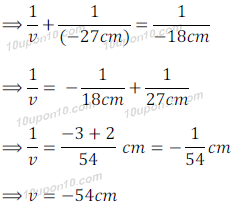
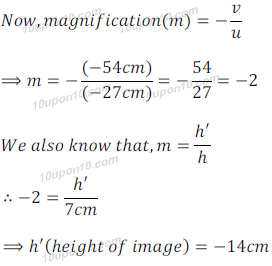
Thus,
To obtain a sharp and focused image, screen will be placed at a distance of 54cm in front of mirror.
Position of image = 54 cm in front of mirror.
Size of image = 14 cm, i.e. double size of object, i.e. enlarged.
Nature of image = Inverted and real (Because magnification and distance of image are in negative)
Question: 16. Find the focal length of a lens of power – 2.0 D. What type of lens is this?
Answer: Given,
Power of lens (P) = – 2.0 D
Thus, focal length (f) =?
We know that, P = 1/f
Or, – 2.0 D = 1/f
Or, f = 1/– 2.0 D
Or, Focal length (f) = – 0.5 m
Since, power of length is in minus, thus it is a concave lens.
Question: 17. A doctor has prescribed the corrective lens of power + 1.5 D. Find the focal length of the lens. Is the prescribed lens diverging or converging?
Answer: Given,
Power of lens (P) = + 1.5 D
Thus, focal length (f) =?
We know that, P = 1/f
∴ + 1.5 D = 1/f
Or, f = 1/1.5D =0.66 m
Thus, focal length of the lens is equal to 0.66 m.
And lens is converging because power given has positive sign.